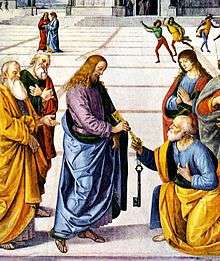Diocesan bishop
A diocesan bishop, within various religious denominations, is a bishop (or archbishop) in pastoral charge of a(n arch)diocese (his (arch)bishopric), as opposed to a titular bishop or archbishop, whose see is only nominal, not pastoral.[1]
In relation to other bishops, a diocesan bishop may be a suffragan, a metropolitan (if he is an archbishop) or a primate, and may also hold various positions such as cardinal or patriarch.
Titular (arch)bishops, on the other hand, may be assistant bishops, coadjutor bishops, auxiliary bishops, nuncios or similar papal diplomats, officials of the Roman Curia, etc., and likewise may also hold other positions such as cardinal.
Roman Catholic Church
| Part of a series on the |
| Hierarchy of the Catholic Church |
|---|
 |
| Ecclesiastical titles (order of precedence) |
|
|
Liturgical titles |
|
Administrative and pastoral titles
|
|
Consecrated and professed titles |
|
Organization titles |
|
|
- See also: Catholic Church hierarchy § Diocesan bishops and Bishop (Catholic Church) § Diocesan bishops or eparchs
Diocesan bishop
A "diocesan bishop" [2] — in the Catholic Church — is entrusted with the pastoral care of a local Church (diocese), over which he holds ordinary jurisdiction.[3] He is responsible for teaching, governing, and sanctifying the faithful of his diocese, sharing these duties with the priests and deacons who serve under him.[4]
Coadjutor bishop
The Holy See can appoint a coadjutor bishop[5] for a diocese. He has special faculties and the right of succession.
Auxiliary bishop
The diocesan bishop may request that the Holy See appoint one or more auxiliary bishops, to assist him in his duties.[6]
Bishop emeritus
When a diocesan bishop or auxiliary bishop retires, the word "emeritus" is added to his former title, i.e., "Archbishop Emeritus of ...", "Bishop Emeritus of ...", or "Auxiliary Bishop Emeritus of ..." Examples of usage are: "The Most Reverend (or Right Reverend) John Jones, Bishop Emeritus of Anytown"; and "His Eminence Cardinal James Smith, Archbishop Emeritus of Anycity". The term "Bishop Emeritus" of a particular see can apply to several people, if the first lives long enough. The sees listed in the 2007 Annuario Pontificio as having more than one (Arch)Bishop Emeritus included Zárate-Campana, Villavicencio, Versailles, and Uruguaiana. There were even three Archbishops Emeriti of Taipei. The same suffix was applied to the Bishop of Rome, Pope Emeritus Benedict XVI on his retirement.
See also
Footnotes
- ↑ Code of Canon Law (1983), canon 376. Quote=Bishops to whom the care of some diocese is entrusted are called diocesan; others are called titular Archived February 19, 2008, at the Wayback Machine.
- ↑ "Canon 376". 1983 Code of Canon Law. Libreria Editrice Vaticana. Archived from the original on 19 February 2008. Retrieved 27 July 2009.
- ↑ "Canon 369". 1983 Code of Canon Law. Libreria Editrice Vaticana. Archived from the original on 19 February 2008. Retrieved 27 July 2009.
- ↑ "Canon 381". 1983 Code of Canon Law. Libreria Editrice Vaticana. Archived from the original on 19 February 2008. Retrieved 27 July 2009.
- ↑ "Canon 403 §3". 1983 Code of Canon Law. Libreria Editrice Vaticana. Archived from the original on 19 February 2008. Retrieved 27 July 2009.
- ↑ "Canon 403 §1". 1983 Code of Canon Law. Libreria Editrice Vaticana. Archived from the original on 19 February 2008. Retrieved 27 July 2009.